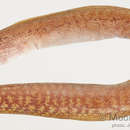Diagnostic Description
provided by Fishbase
Color yellowish, mottled and irregularly barred with brown shading to whitish ventrally on head and abdomen. Further characterized by body depth at gill opening 18-23 in TL; origin of dorsal fin slightly closer to gill opening than corner of mouth; anus anterior to middle of body; front of upper jaw with three rows of teeth with 3-4 canines on outer row on each side, small teeth in between; two large canines of middle row; side of upper jaw with outer row of small teeth; about four large teeth in inner row; row of small teeth on each side of lower jaw; front of jaw with two pairs of small canines (Ref. 90102).
- Recorder
- Estelita Emily Capuli
Life Cycle
provided by Fishbase
Protogyny unconfirmed (Ref. 84746).
Morphology
provided by Fishbase
Dorsal spines (total): 0; Dorsal soft rays (total): 0; Analspines: 0; Analsoft rays: 0; Vertebrae: 126 - 143
- Recorder
- Estelita Emily Capuli
Trophic Strategy
provided by Fishbase
Occurs at reef flats and outer reef slopes to a depth of at least 20 m. Unlikely to be encountered without the use of ichthyocide (Ref. 1602, 37816).
Biology
provided by Fishbase
Occurs at reef flats and outer reef slopes to a depth of at least 20 m. Feeds on fishes, cephalopodes and crustaceans (Ref. 89972). Unlikely to be encountered without the use of ichthyocide (Ref. 1602, 37816, 58302). Benthic (Ref. 58302). Possibly a protogynous hermaphrodite (Ref. 32169). Common, but highly cryptic and seldom seen (Ref 90102).
- Recorder
- Estelita Emily Capuli
Importance
provided by Fishbase
fisheries: of no interest
- Recorder
- Estelita Emily Capuli
分布
provided by The Fish Database of Taiwan
分布於印度-太平洋區,西起東非,東至萊恩及社會群島,北至日本,南至澳洲大堡礁等海域。臺灣分布於南部、東部、澎湖和蘭嶼等海域。
利用
provided by The Fish Database of Taiwan
一般可利用延繩釣、手釣和籠具誘捕等漁法。可食用性。
描述
provided by The Fish Database of Taiwan
體延長而呈圓柱狀,尾部側扁。吻尖長,頜間齒長尖牙狀。其他大的尖牙位於頜部前端及上頜頜齒內列。脊椎骨數128-132。本種體色及斑紋頗有變異,底色可由黃褐、綠褐至深褐色;眼斜後上方有一列黑褐色斑向尾部方向延伸;前鼻管黑色;下頜白色。
棲地
provided by The Fish Database of Taiwan
主要棲息於淺海珊瑚、岩礁的洞穴及隙縫中。以魚類為主食,偶食甲殼類。
Blotch-necked moray eel
provided by wikipedia EN
- license
- cc-by-sa-3.0
- copyright
- Wikipedia authors and editors
Blotch-necked moray eel: Brief Summary
provided by wikipedia EN
The blotch-necked moray eel (Gymnothorax margaritophorus) is a moray eel found in coral reefs in the Pacific and Indian Oceans. It was first named by Pieter Bleeker in 1864, and is also commonly known as the blackpearl moray, pearly moray, pearly reef-eel, or the trunk-eyed moray.
- license
- cc-by-sa-3.0
- copyright
- Wikipedia authors and editors
Description
provided by World Register of Marine Species
Occurs at reef flats and outer reef slopes to a depth of at least 20 m. Unlikely to be encountered without the use of ichthyocide (Ref. 1602).
Froese, R. & D. Pauly (Editors). (2023). FishBase. World Wide Web electronic publication. version (02/2023).
- license
- cc-by-4.0
- copyright
- WoRMS Editorial Board

